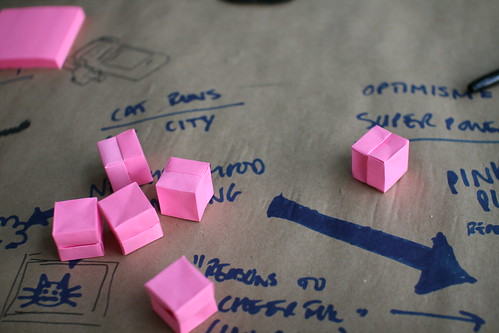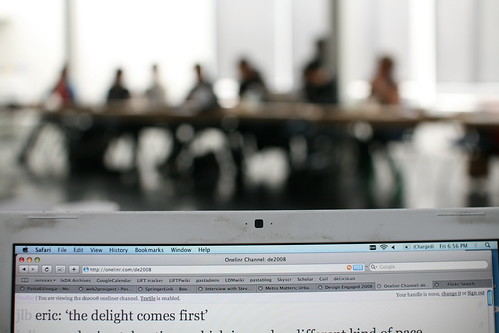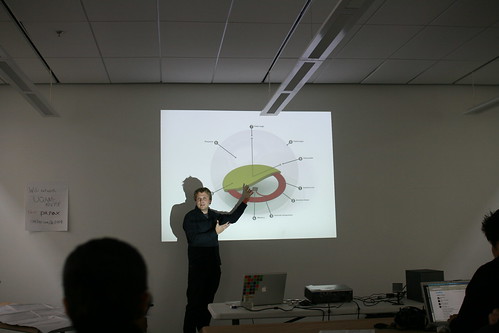 Very good week-end in Montreal at Design Engaged few days ago. Took time to cobble my notes form the whole thing.
Very good week-end in Montreal at Design Engaged few days ago. Took time to cobble my notes form the whole thing.
DE is a designers get-together with a good mixture of practitioners and theorists. The events itself is not a conference nor a workshop but a sort of informal gathering of people who talks (through newcomers presentations), listens, walk in the city (saturday afternoon breaking out groups), eat and sketch (sunday morning use of material collected during the walk). As Andrew Otwell described in his introduction, these activities were meant to support the discussion of "models and visions about the future".
Coming from a sinuous academic background in both hardcore sciences and social sciences, I was kind of intrigued at first by the use of the "model" (by Andrew in his intro and Ben Cerveny in his conclusion). This notion was sort of prevalent over the week end, referring both to models built by designers concerning how they imagine future objects in their ecosystems and meta-models employed by theorists. As Andrew said "designers are constantly making models, that's what the job is, making complete vision of the future" and at the same time other actors (quant in finance) are failing to use their own models to predict the future. The session therefore started around this notion that the "the future wasn't what it used to be", which kind of echoed with my presentation. The "future" seemed also a recurring topic over the week-end with different talks which deal with how we're sort of lost in translation from an epoch with a clear future endpoint to now where the present overflowed the future.
Raphael Grignani started off with a presentation about the Five Dollar Comparison project he and others carry out at Nokia Design. This project explores the relative value of five dollars and consists in a collection of examples from around the world. It takes the form of photos of objects or services that cost the equivalent of $5. Raphael showed some example of what you can get in the world for 5$: goods (foods, hawaianas, beer, BW passport photos, libido enhancers in china, startac phone on ebay), services (motorbike ride). What's maybe more interesting to me here was the discussion of why this has value for Nokia Design: it disrupts processes they have, give crowdsourcing insights, allows alternative funding, enable social responsability (for each picture, submitted to the group, give $5 to a charity), use of creative commons and make peopel realize that doing small things by big numbers has a huge impact.
Ruth Kikin-Gil, a designer who works at Microsoft, gave an insighftul presentation about how and why Strauss and Howe's generation theory are relevant and interesting for design. As she said, it allows to ask questions more than getting answers. She also described how they use generations as personas as well as the different technological framework (personal computers, mobile computing, social networks...) for each generation. That talk led to an interesting discussion of nostalgia and forward-looking attitude exemplified by the following example: 2 geeks talking with each other: one shows his phone to the other: "look! that's what you looked like five seconds ago".
A side comment from Matt Webb on the backchannel was that "designing to meet observed needs reinforces structure and removes its capacity to invent futures", something that I've found interesting as my work is about capturing elements regarding people (be it needs, motivations, contextual insights, etc.). There is indeed a tension between....
The following highlight from from Eric Rodenbeck (Stamen) who talked about gardening and why it's interesting for data visualization. Gardens are strange spaces where life can grow, places where there is not necessarily order but they bring manifest what is important about our future. He sees Stamen's projects as garden: it's not useful but it's delightful, it's cultivate to delight; it's not quite useful, not quite art but "it's a start", which is highly important. What Eric finds interesting is that it's not necessarily articulate but it's there.
Then Kevin Cheng dealt with lazy-generated content, some concepts I was interested in for a foresight project about the Web.
In the afternoon of the first day, near-future laboratory partner Julian talked about "Design Fiction: Something and the Something in the age of the Something". A memorable and insightful discussion which echoed with my own presentation.
Starting by interrogating the representation of the future, he questioned how we imagine what can come to be, what are the ways the futures will be and how these elements shape what we consider reasonable and possible futures. Change is often seen as inevitable and a linear model as if there were always one sort of alternative. In addition, "the future is here, it's just not evenly distributed" from William Gibson led to the "sandwich spread representation of the future": the representation of the future is lumpy in bits dans doesn't get to everyone evenly. Some people receive the future more than other, some try weird things to "live in the future" and it's hard to explain to parents, siblings, etc. One of the slides interestingly referred to possible quotes by Bruno Latour ("...") to show the 3D linkages of human/non-human collectives representation of the future, another important aspect Julian brought to the table. What he meant is simply that complex knots and linkages between many disparate social practices create thick representations of human activities, including our projections and imaginations about the future.
The second part of his talk was about ubiquitous computing is related to science-fiction, based on a forthcoming paper by Paul Dourish and Genevieve Bell. For instance if you type "minority report interface" in google you get some links about engineers, scientists, etc. It shows the entanglement between what people do in laboratory and steven spielberg's team, this slippery zone that reveals the blurriness between scifi and ubicomp... a promising area to explore. Lots of sci-fi pieces put together to fashion a perspective that tell a story about ubiquitous computing-y things as they are projected into sci-fi narratives. However, as Julian expressed, Ubicomp is Sci-Fi since it use sci-fi as a reference point for engineers and scientists in the lab. In the end, what we have is the deployment of an idea-mass 3D Latourian representation of the future: conversations shaped by human and non-human objects, their circulation which eventually draw more agents.
The last part of his talk concerned the importance of props and prototypes, which can take 2 forms: in their canonical form (the kind of stuff you build, scaffolding around ideas) OR David A. Kirby's diegetic prototypes (how prototypes and narrative ones shape an influence). The latter was described with the following quote from the RHCP: "space may be the final frontiers, but it's made in a Hollywood basement" (Californication, 1999!): being able to make the things and wrap them into a narrative form. To some extent, prototypes/props are idea-mass: they are objects that have attractive forces, enroll people and design can also be a kind of fiction making: design-fiction. In other words, stories matter when designing the future and perhaps even more than the "real thing". Julian then sees design as speculative prototyping, things that are real scifi, really curious and orthogonal to the conventions of technology-market-economies. And the measure of success is when someone says "stupidest fucking idea EVER" (jonah brucker-cohen).
He concluded on these 5 points:
- objects tell stories for people, not scenarios for users
- there are many futures, no inevitabilities
- makes lots of stuff quickly
- assume weird (or no) market models, weird imaginary worlds
- assume you are from the future
His talk obviously gave a great framework for Anab Jain's talk, as if her beautiful projects (Yellow Chair, the Gubbins as well as this awfully nice map powered by sugar which starts dying) were perfect examples of what Julian just said. I am looking forward to read this "Objects incog" book from the project she did with Alex Taylor ("Life and Death in Energy Autonomous Devices"). I particularly love the notion of aging objects and decay as a mean to show that death is very close, and it's acknowledged by the user, trying to figure out what it means. Mouna Andraos's "From craft to designing experiences" work and Tuur Van Balen's "My city = my body" also fitted very well in the picture.
After my talk, Molly Wright-Steenson spoke about the "anterior future" (the french tense) and some enquiries about past versions of the future ("how old are our futures? where did our futures comes from?"). It's always intriguing to nail down the obscure french authors Molly is using in her theoretical work. People such as Etienne-Louis Boullée for instance. Surely some food for thoughts to integrate to my own thinking about failed futures.
From Aaron Cope's talk about sensor porn. I liked his way to figure out what happen when the system breaks and how what that means the common perception is that we will just adapt. I now keep in mind the two following quotes he referred to and that I found insightful:
" We should be mapping information that in some ways has been historically un-mappable because it is 1) not valued or is 2) actively seen as threatening or is 3) simply too hard to map using traditional GIS" Anselm Hook
"It is this narrow definition of context that makes life harder for ourselves, because adding more and more sensor readings is not really the same thing as adding more and more context" Dawns Nafus
I loved Russell "i do this sort of project that involves printing the internet out" Davies as well as Schulze and Webb's presentation but at that specific moment, I stopped taking notes, enjoying the whole show ;) Both presentations were insightful
Timo Arnall's presentation about "visible present branded" was also interesting to me both because I am interested in the topic and as an example of cutting edge digital design practice. Starting form Dourish and Bell's characterization of uibcomp, Timo introduced his interest towards RFID objects as building blocks of ubiquitous computing: they are highly designed and visible, branded and it's stuff not that emerges only from engineering.
The first point Timo made was to show the importance of visibility/invisibility of interactions. Some examples: Hertzian tales by Anthony Dunne (invisible radiowaves leaking out people's houses into public space) + semiconducor that represent electromagnetic fields as very visual, hairy and unstable, sort of artistic interpretation of how fields behave ("from a viz POV it's beautiful, put images in my head") + the bubbles of radio (characterized radio fields through visual characters).
From a pragmatic perspective, timo is interested by invisible affordances of things, he and his colleagues worked on a rigorous analysis of how we signify/flag up different aspects of ubicomp, also worked on icons, to expose what is invisible. The invisibility can be a confusing model, a limiting model for ubicomp. What is happening is that things always become visualized; when sensors emerges into space you see "do this do that" (tap sensor). He looked at signage related to wireless: often represented as 3 concentric rings... interesting from the visual design perspective: when points up: positive, when points down or lateral: security. Looking at the visual vernacular of RFID allows to understand how it is represented. This is beginning to affect the ways we interact with things: the gestures people used to swipe cards, intimacy of touching phones for rfid contacts. Their next step is to sketch out what fields do, what material, what properties, represent field lines but these viz do not necessarily give way to tell how to interact with technologies!
Using an "RFID pen" that draws when it detects an RFID signals, they made a 3D picture of an RFID field viz of the actual readable volume around a coiled RFID antenna. It's an experiment in field drawing: as shown on this video. The en result is an interesting shape with properties. What are the implications? it's good to have a model but even more interesting to see what that means for interaction:
- different feeling of interactions depending on how close the tag is to the reader
- the physical object can interact + or - with the field
- different shapes of the rfid reader can be analyzed and producted... use it as an idea generation
- investigate how the field (which surround the device) is a material for interaction
tool... like tag rader in a shape of a bowl, a sniffing dog that snifs objects
The purpose now for Timo and his colleagues is to turn an engineer-based technology in sth designers can look at, turn RFID into sth that has clear affordances for design as represented on the pic above: presence, memory, internal connections, antenna shape, antenna size, enclosure, field range, field width, field width. These are the important thing for designers to work with. I really enjoyed both that slide and the methodology they dealt with to come up with this list of affordance, there's really something innovative here. Simply, it's beyond lots of research I've seen in ubicomp papers and the perspective/tools they employed allowed them to (1) ask new questions, (2) come up with an interesting set of answers.
Ben Cerveny' conclusion about "Flocking through utopias" was a nice endpoint for DE. Ben showed how an event such as Design Engaged can be seen as "team sport, a self-organized school, collaboratively browsed" which allows to explore the space, like a cultural exchange. This "social club" would then have the following characteristics:
- discontinuity: it turns things are falling apart, critical moment... at the same time, other people (quants) works on developing model (viz, metaphor) for the future. that team did not won the medal this year because of that, there are some things that need reforming, DE as a group can provide new models
- optimism: there is no shiva in the west; when things fall apart in the west, this is bad however if things don't fall apart, that's death; if a system is not changing, it's over complexity, emergence happens in growth/decay cycles so we have to embrace decay
- possibility surfers, playing with models/possibilities, step out into the meta, look where value is going
- use the ultimate social object: utopia: how to build community around utopias, grand projects
- what we do is a game of system models with prototypes from alternative universes, they're not from the future, but they propose new set of design, bring probes from that space: ultimately, it allows to build a very large model
Surely a great event with a wide set of perspective. I particularly liked the mix of perspectives ranging from presentations of design projects, theoretical presentations and pragmatic views. Thanks Andrew, Boris, Jennifer and Mouna for the invitation and setting this up. My take away of the event below.


